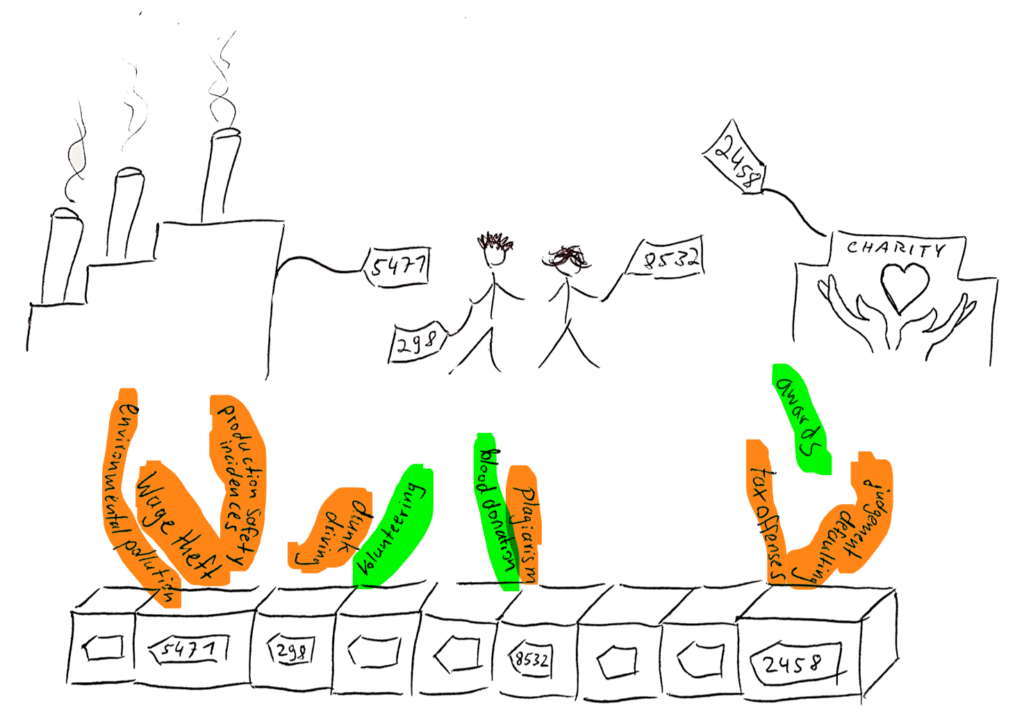
‘The trustworthy shall roam everywhere under heaven, while those who breach trust shall not be able to move a single step’ is the underlying maxim of China’s Social Credit System (SCS) project. Taking a step closer to understand what is behind this rhetoric quickly reveals that the SCS is better to be spoken of in plural, and the initiatives proliferating under it include projects as various as commercial loyalty programs, market regulation measures, and judicial enforcement mechanisms. But what does the central government envision in terms of a comprehensive system? We may find answers by looking at how the central government organs in charge of SCS building regularly assess the progress of the pioneers, cities. This is done through quantified criteria, so called SCS Construction Assessment Indicators. They offer a rare comprehensive depiction of how the perfect municipal SCS looks like in the eyes of the central planners. Based on these criteria, Marianne von Blomberg lays out what it takes to build a municipal SCS.
The National Development and Reform Commission and the People’s Bank of China, two major players in SCS creation, annually issue assessment indicators to evaluate the progress cities make on that front. Those performing best are designated “SCS construction model cities” (社会信用体系建设示范城市). Each of the twelve indicators in every set deals with what may be understood as one construction site within the larger SCS project. This is how they work: For progress on each site, cities get points. Further, a set of “hard indicators” includes ten concrete goals “which all must be completed without exception”. They may be regarded as centrally designed manuals for municipal SCS building which are handed to local leaders.
Filling a gap between the broadly termed conceptual central documents and the orders, legislation and specifications scattered across localities and realms which each relate to one of the SCS’s many parts, they are a rare official depiction of the whole SCS which is, moreover, translated into concrete criteria.
Step 1: Build your infrastructure for credit information production & sharing
The code: Under the unified social credit code, the gathered credit information is allotted to the then credit subjects. Issuing this code to legal persons and other organizations is a first fundamental element in SCS construction that reappears in all sets of indicators with the bar to earn points being raised throughout the years.

The records: Credit information is stored in credit records (信用记录, sometimes: sincerity files 诚信档案) that are to be set up by departments in charge of more than 21 realms as various as tax collection, construction, transport, e-commerce, birth control, education and research, environmental protection, law firms and lawyers, notaries, and for civil servants. In addition, the judiciary and providers of public utilities such as water, electricity and telecommunication are to gather and share information. What amounts to credit information differs across localities and administrations, it is commonly stipulated in credit information catalogues (find an example of such a catalogue here). As of 2019, Hangzhou has collected 140 million pieces of credit information, Suzhou has collected 350 million pieces, and Nanjing 1,4 billion (Zhu Lili 祝丽丽 2019).
The platform: Such credit information, once gathered, is directly to be forwarded to the credit information sharing platform (信用信息共享平台). The indicators of 2016 were the last to ask for the creation of such a platform, it was in the following years treated as given prerequisite. Its vital role in the system is illustrated by the fact that approximately one fourth of all points can only be attained if the platform is constructed. One indicator reads: “0.5 points are deducted for every city-level unit that is not connected to the credit sharing platform and sharing their information”. However, the experience of SCS construction model city Zhengzhou shows that linking up the platform with the sources of information such as administrative departments and providers of public utilities is a significant challenge.
Step 2: Make trustworthiness records the basis for decision-making in public administration
Joint reward and punishment: Joint reward and punishment (联合奖惩) refers to the realization of punishments and rewards in one realm to those entities who have been enlisted for trust-breaking or exemplary trustworthy behaviour in another realm. The ban to book high-speed trains for those who have defaulted on court judgments is an example. Joint reward and punishment was, upon the announcement of the first batch of model cities described as the “ring in the bull’s nose” of SCS construction, that, if being taken care of, will “cause all smaller things to follow.” Correspondingly, it has steadily gained importance in the indicators: 11% of all points in 2017 are to be achieved by implementing joint reward and punishment, jumping to 21% in 2018, and to 22% in 2019. Cities can gain points for example for each case where joint punishment was meted out against a trust-breaking entity or where benefits materialized for the red-listed, as well as for institutionalization of joint reward and punishment, meaning its integration in information systems and work procedures. Hard indicator 11 requires that “the number of realms where the city implements joint reward and punishment is not less than the respective number of realms at national level”.

Regulation by credit classification (信用分级分类监管) refers to adjusting the intensity of market regulation measures, such as random inspections, to the credit status of the relevant subject. Regulation by credit classification is on the ascendant, with a rise in proportional value within the respective sets of indicators of 9%, to 17%, to 22% from 2017-2019. This “novel type of regulation” is not only overhauling traditional market regulation but increasingly a tool for administrative agencies concerned with other realms. Since 2017 it has been woven into other indicator groups such as commercial sincerity, social sincerity and judicial credibility construction.
Step 3: Foster a market for credit products for individuals that make use of public credit information
A score: A municipal social credit score is to be set up for the respective city’s residents using their social credit information (this is what in Hangzhou is called the Qian River Score, in Fuzhou the Jasmin Score, in Suzhou the Osmanthus Score, etc). Through the “credit+ programs” enumerated below, public credit information translated into the score indeed follows a subject into numerous areas in daily life- in a rewarding manner.
Credit+ programs: Integrating market forces has helped to develop credit products that are to be used by local administrations in their daily work so that social credit information directly impacts how convenient a citizen’s everyday life is. In the 2017 indicators still vaguely termed “sincerity conveniences in public service”, the concept has matured into fully-fledged programs such as “credit easing procedure” (信易批) in the course of which administrative agencies tolerate the lack of secondary documents when proceeding requests of high-scorers. Likewise, “internet+credit+medical treatment”, “internet+credit+elderly care”, “credit easing transport” and “credit easing loans”, to name just a few of those programs enumerated in the latest set of indicators, allow high-scoring subjects certain privileges such as fast track handling of paperwork at hospitals.
Step 4: Equip your SCS with remedial paths- or don’t
From a legal point of view it appears striking that the objection procedures laid out at some length in province-level social credit regulations and recently reemphasized by the latest central level SCS guideline are not mentioned throughout the indicators. A careful deduction we can draw from that and the fact that the author could not yet find legal cases involving relevant provisions is that the focus of municipal SCS building lies on pushing forward the system’s coverage first.
Credit Repair: Not strictly speaking a remedial measure, credit repair (信用修复) refers to a procedure with the help of which credit subjects can have unfavourable credit information deleted and relevant punishment halted. They are required to eliminate all damages caused by their “untrustworthy” behaviour, or where that is not applicable, undergo “credit repair trainings”. The indicators award points to cities for cases of successfully completed trainings (possible in online formats and without final exam, making them easily circumventable) and the de-blacklisting of entities as a result of such.

Step 5: Make sure your city has a sound financial environment
Interestingly, the indicator on constructing a trustworthy financial eco-system seems to be standing on its own- other than the other indicators, it makes no mention of the credit sharing platform, blacklists, credit records, regulation by credit classification or other central SCS tools. Instead, points are given to cities on the bases of whether normatively, the level of trustworthiness is high. For instance, where no significant regional financial risk has occurred, the 2019 Indicators award two points. While most of the indicators seek to have a system of dealing with specific trust-related problems set up, the indicator on the financial eco-system is less concerned with SCS infrastructure building, but with the greater goal to achieve a more trustworthy financial environment. Further, this indicator alone is to be evaluated not by the assessment groups that handle the other indicators but by the PBoC alone.
Extras
Political ideology: It is less helpful for municipal SCS designers aiming for the title of SCS model city to put much effort on living up to political rhetoric. While the indicators do mention the ubiquitous Xi Jinping Thought, implementing the CPCCC’s and the State Council’s directives on the SCS (all eleven of them which are enlisted, translations here), and Socialist Core Values- The relevance of these elements in relation to the other indicators shrank from 11% in 2017 to 8% in 2018 and 2019, the 2016 indicators and the hard Indicators do not mention them at all.
Innovations and making use of local specialities: Notably, not even this indicator that explicitly encourages experimentation and lists examples mentions the application of AI and other technology that is frequently associated with the SCS. Indeed, the most high-tech element the indicators lay down is the building of the information sharing platform and credit websites. Most technological innovation for municipal SCSs appears to happen within the private sector: Cities gain points for fostering a market of credit products. How such products may eventually be “incorporated” into the larger, centrally driven project was demonstrated in early 2018: The PRC’s first credit scoring services that were given licenses to experiment with their products did not get the license in the end but were made minority shareholders of one PBoC-lead Credit Scoring entity called Baihang Zhengxin (百行征信, the whole story).
Marianne von Blomberg is a PhD Candidate at Zhejiang University’s Law School and Cologne University’s Chair for Chinese Legal Culture and working as a Research Associate with the latter. She is particularly interested in the intersections of the law and social credit and recently focuses on reputational sanctions within the Social Credit System. Get in touch with her on LinkedIn or follow her on Twitter.
